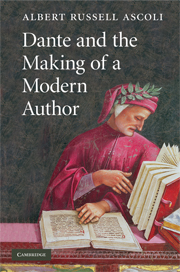Book contents
- Frontmatter
- Contents
- Preface
- Abbreviations of primary texts and translations
- INTRODUCTION
- Part 1 AN AUTHOR IN THE WORKS: DANTE BEFORE THE COMMEDIA
- Chapter 2 Definitions: The vowels of authority
- Chapter 3 Language: “Neminem ante nos”
- Chapter 4 Auto-commentary: Dividing Dante
- Part 2 AUTHORITY IN PERSON: DANTE BETWEEN MONARCHIA AND THE COMMEDIA
- Works consulted
- Index of proper names and works cited
Chapter 2 - Definitions: The vowels of authority
Published online by Cambridge University Press: 22 September 2009
- Frontmatter
- Contents
- Preface
- Abbreviations of primary texts and translations
- INTRODUCTION
- Part 1 AN AUTHOR IN THE WORKS: DANTE BEFORE THE COMMEDIA
- Chapter 2 Definitions: The vowels of authority
- Chapter 3 Language: “Neminem ante nos”
- Chapter 4 Auto-commentary: Dividing Dante
- Part 2 AUTHORITY IN PERSON: DANTE BETWEEN MONARCHIA AND THE COMMEDIA
- Works consulted
- Index of proper names and works cited
Summary
THE PROBLEM OF CONVIVIO
Dante's quest for special cultural standing, for authority in a general sense, began very early in his career. As will be seen better in Chapter 4, Vita Nova's idiosyncratic adaptations of the Latin commentary tradition to the glossing of Dante's poetic texts aim at locating him in the structural position of the auctor, and this in 1293, when he was still in his twenties. The third chapter of the “libello” apparently documents a significantly earlier step in this process. By sending out the cryptic poem “A ciascun'alma presa e gentil core” to a circle of Tuscan poets, whom Dante calls the “fedeli d'amore,” including his “primo amico” Guido Cavalcanti as well as Dante da Maiano and, more doubtfully, Cino da Pistoia, for interpretation, he asserts his own significance within a locally prestigious community and places his work in the authoritative position of receiving readerly commentary, albeit that of modern vernacular writers like himself.
At the same time, however, in this early work Dante scrupulously avoids using the words autore and autorità, much less their Latin equivalents. The proof case here is the chapter traditionally numbered 25.
- Type
- Chapter
- Information
- Dante and the Making of a Modern Author , pp. 67 - 129Publisher: Cambridge University PressPrint publication year: 2008



